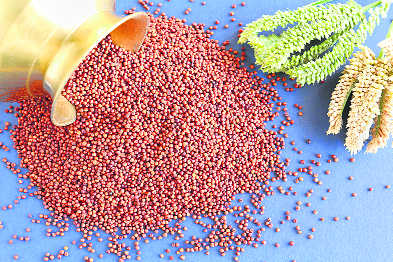
Commonly associated with deserts and poverty, millets are some of the oldest and cheapest of cultivated crops known to humans. Because of their thicker outer coats, they are also known as 'coarse grains'. Unlike wheat and rice, these crops consume little water, need no irrigation and are adaptable to a wide range of ecological conditions. Hardy in nature, they grow even in drought conditions and attract few pests. Being excellent source of essential nutrients, they are also called as 'high energy-nutritious foods'.
Although, nutritionally similar, some of them have unique advantages. On an average, they contain 10-12 per cent protein including high levels of good quality protein (methionine, cystine) and other vital amino acids for human health. Millets also form a good source of fiber, especially insoluble fiber. This insoluble fiber helps to decrease transit time and prevent gastrointestinal discomfort. They are also unique sources of pro-vitamin A (yellow pearl millets) and micronutrients (zinc, iron and calcium). Ragi is particularly rich in calcium and Bajra is in iron. The high proportion of cellulose (fiber) and anti-nutrients like phytates and tannins in millets interferes with the absorption of minerals. Soaking, fermentation, germination of millets enhances bioavailability (absorption) of these minerals. Infact, these nutritious-high energy- hypoallergenic foods can form an important part of the diets of infants, lactating mothers, elderly and convalescents. However, those unaccustomed to these coarse grains may experience abdominal discomfort after eating large portions.
They are also a potentially important source of nutraceuticals and antioxidants like phenolics, tannins, and phytates and cholesterol-lowering waxes, especially in sorghum. Millets lack gluten (the wheat protein), thus can form an important component of gluten-free diets or those with celiac disease or are wheat intolerant. A recent study reported that consumption of finger millet based diets are helpful for people with diabetes. The study reports a lower glycemic response of whole finger millet based diets which may also have been due to the presence of antinutritional factors in whole finger millet flour which are known to reduce starch digestibility and slow absorption.
A study also reports that dietary phytate helps prevent kidney stone formation, protect against diabetes mellitus, caries, atherosclerosis and coronary heart disease as well as against a variety of cancers.



























